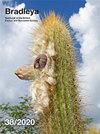Notes on the identity of Echinocactus conglomeratus – a name of uncertain application from northern Chile
IF 1.2
4区 生物学
Q3 PLANT SCIENCES
引用次数: 0
Abstract
Summary: The name Echinocactus conglomeratus published by Rodolfo Philippi in 1860 has remained of uncertain application although it is generally accepted to belong to the genus Copiapoa. Two attempts have been made to neotypify the name but neither is convincing as both taxa have characters which are inconsistent with the description of E. conglomeratus. Both neotypifications are rejected here due to conflict with the protologue. This paper investigates the account published by Philippi of the part of his journey through the Atacama Desert where he reports finding E. conglomeratus. Secondly a comparison is made between the description of E. conglomeratus and all of the Copiapoa species now known to grow in that area. Unfortunately, it is not possible to state with certainly which known species can be assigned to E. conglomeratus and so no typification is proposed. It is recommended E. conglomeratus is considered a name of uncertain application and its usage abandoned.智利北部一种应用不确定的名称——棘蟹属(Echinocactus glomeratus)的鉴定注记
摘要:鲁道夫·菲利皮(Rodolfo Philippi)于1860年发表的Echinocatus conglomeratus这个名称虽然被普遍认为属于Copiapoa属,但其应用仍不确定。已经进行了两次尝试来对该名称进行新类型化,但都没有说服力,因为这两个分类群的特征都与E.conglomeratus的描述不一致。由于与原论的冲突,两种新典型化在这里都被拒绝了。本文调查了Philippi发表的关于他穿越阿塔卡马沙漠的部分旅程的描述,他报告在那里发现了E.conglomeratus。其次,比较了该地区目前已知的所有Copiapoa物种和E.伴聚体的描述。不幸的是,目前还不可能确定哪些已知物种可以归属于E.conglomeratus,因此没有提出典型化的建议。建议将E.conglomeratus作为一个应用不确定的名称,并放弃其用途。
本文章由计算机程序翻译,如有差异,请以英文原文为准。
求助全文
约1分钟内获得全文
求助全文
来源期刊

Bradleya
PLANT SCIENCES-
CiteScore
2.80
自引率
25.00%
发文量
43
审稿时长
>12 weeks
期刊介绍:
Bradleya is the BCSS contribution to the scientific world and is accepted as such because of its academic standards. It can only flourish with the support of BCSS members, many of whom subscribe to it each year. The aim is to include articles which our members will find interesting and educational, whilst retaining rigorous standards of publication. Scientifically important articles don''t have to be dull to read. So, because Bradleya depends the subscriber, the editor endeavours to make its contents accessible, easily understood and enjoyable for all.
 求助内容:
求助内容: 应助结果提醒方式:
应助结果提醒方式:


